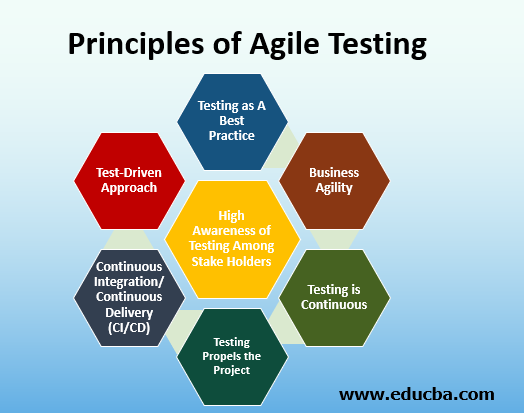Updated March 18, 2023
Introduction to Agile Testing
Agile Testing is testing that is performed parallel to development from the beginning stage of development through each sprint/ iteration until other testing processes. This testing includes test documentation, test data preparation, testing, retesting, defect tracking, etc. which are done in parallel along with each and every step of development. So, the Agile Testing method is a continuous delivery-driven process aligned with the given functional/ non-functional requirements. Agile Testing is an integral part of agile development in which the software solution is delivered incrementally in phases instead of doing it as a single lot at the end.
Agile Testing is a crucial step in the software development life cycle (SDLC) and it guarantees that all the functions and features of the software works as per its original specifications. Defects in the software due to lack of testing would lead to potential loss of customers, revenue, and brand value to the business.
Traditionally, testing is a distinct phase in SDLC and the testing team used to work in isolation and will get involved only upon completion of development. This has delayed the whole process and affected the quality of software delivery. Agile Testing addresses the issues in the traditional testing methodology.
Difference Between Traditional Testing and Agile Testing
Difference between the traditional testing and agile testing are,
| Traditional Testing (Waterfall Method) | Agile Testing |
| Testing is delinked from development, carried out as separately in the end. | Testing happens along with development, making delivery of projects in shorter cycles a reality. |
| Testers work independently and they never mingle with developers. | The testing team is part of an agile core team and they mingle with the development team closely. |
| Tester’s experience is not utilized in any development activities. | Testers are involved right from the requirement capturing phase and their inputs are also factored in building a rich User interface (UI) and functionalities. |
| Progresses as per a firm test plan. | The test plan is flexible to accommodate changes in the requirement. |
| An exclusive phase of testing consumes time and hence results in delayed delivery. | No delays since coding and testing go together. |
| Full importance and focus for testing are not visible. | Imbibed into the development process and practiced ruthlessly. |
| There is the possibility of defects in the software delivered. | Defects in the software-controlled efficiently. |
Methodology of Agile Testing
Test scenarios and test cases are prepared upfront, from the System Specification document and verified by the development team and testing starts along with development. The test plan and test cases are developed for every incremental software release (Sprints). Coding along with testing progresses incrementally (in sprints).
This process is iterated till stability and required quality is reached. Subsequently, the software is launched in the pilot and then in a production environment.
Agile Testing Strategies
Due to flexibility in accommodating changes during any time development cycle, Agile testing relies on strategy rather than a firm test plan and it consists of 4 phases,
1. Project Initiation
It covers Initial set up activities such as,
- Finalizing the business case
- Deciding the scope of the project
- Forming the Team with the right skilled people
- Identifying testing tools and methodology
- Drawing the risk mitigation plan
2. Sprints Construction
- The testing team and development team jointly identify a. activities to be completed in each sprint, b. Time duration each sprint will take.
- Deliverables in each sprint are decided upfront.
- While the requirement is finalized, the testing team develops test scenarios and test cases.
- With broad acceptance of the objectives, building the sprints (incremental software solution) starts and scrum master steps in.
- The role of the scrum master is to facilitate and monitor development and testing.
- Concurrent development of codes and testing happens and any defects found are corrected then and there.
- Confirmatory tests are conducted to ascertain whether all the functionalities work as per the requirements. Developers and key users perform these tests and most of them are automated and regression tests are done throughout the life cycle.
- The investigative test covers integration testing, load testing, and security testing.
3. Releases
After completing user acceptance testing, the incremental software code (Sprint) is moved to production. Activities in this phase include End-user training, handholding and support, User manual preparation, marketing, and operationalizing the back-end activities. There should be a periodical review meeting to assess the performance levels and make course corrections iteratively.
4. Production
Post completing all the incremental software releases and the iterative improvements the project gets moved to production and the post-production support is provided by the team.
Any changes made in the software are managed through a change control board and the changes are thoroughly tested for specific functionalities and regression testing is done for overall functionalities before it gets implemented.
Top 7 Principles of Agile Testing
Following is the List of Agile Testing Principles Explained in Details:
1. Continuous Integration/Continuous Delivery (CI/CD)
CI/CD are the important pillars of DevOps and it insists on frequent code movements as against periodical code movements in the conventional method. Agile testing well imbibed into the development facilitates CI/CD implementation.
2. Testing Propels the Project
Feedback provided by the continuous testing removes the hurdle and the project moves to the next stage after fixing the defects observed while testing. Customers would be happy with the final defect-free product.
3. Testing is Continuous
Testing starts from the day the coding starts and testers work with developers in completing testing then and there.
4. Business Agility
The business team also becomes agile with the frequent feedback they get from the agile team of Developers/testers on the progress of the project.
5. Testing as A Best Practice
In an agile environment, testing is given utmost importance and it is followed as a best practice to improve the user experience and gain new customers.
6. High Awareness of Testing Among Stake Holders
Agile testing involves everyone in the development chain in the testing process. Over and above developers & Testers, Business users, customers
7. Test-Driven Approach
Test scenarios and test cases are developed using system specs, the testing team is ready to start even before coding starts. Testing drives the development in an agile environment.
Benefits of Agile Testing
- Defect-free software is delivered on time as planned, leading to customers’ delight.
- Concurrent development and testing avoid communication gaps and misunderstanding thus avoiding wastage of efforts, time, and money.
- Waiting time for customers to avail of the services gets shrunk as the software is delivered as logical incremental units.
Conclusion
Agile testing, apart from benefits to business, helps software vendors to achieve high-quality standards in their software development process and increase their rating in their industry. It also enables them to move forward fast in adopting DevOps principles.
Recommended Articles
This is a guide to What is Agile Testing? Here we discuss the difference between traditional and agile testing along with the top 7 principles and their strategies. You may also look at the following articles to learn more-




